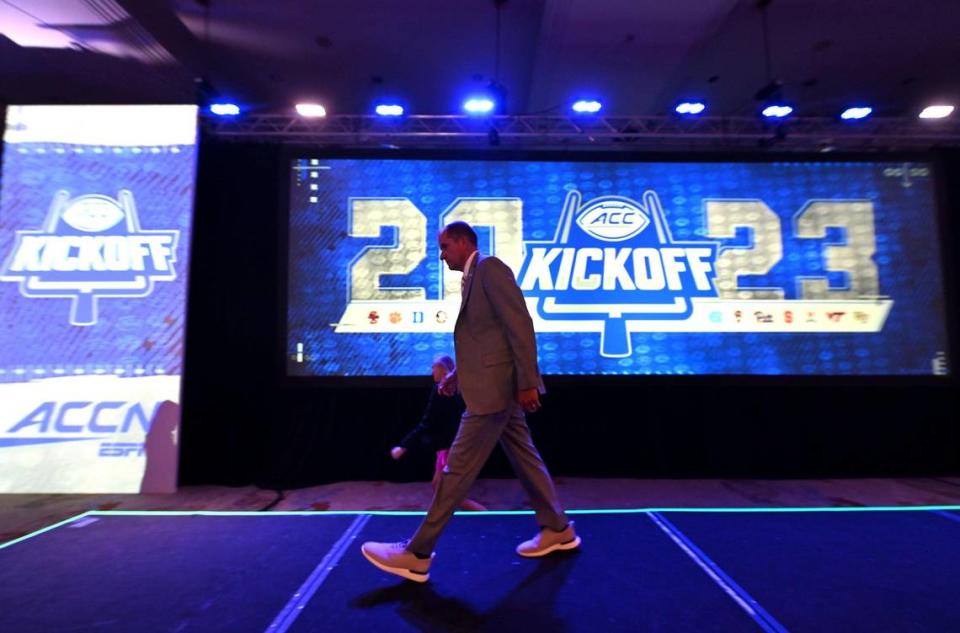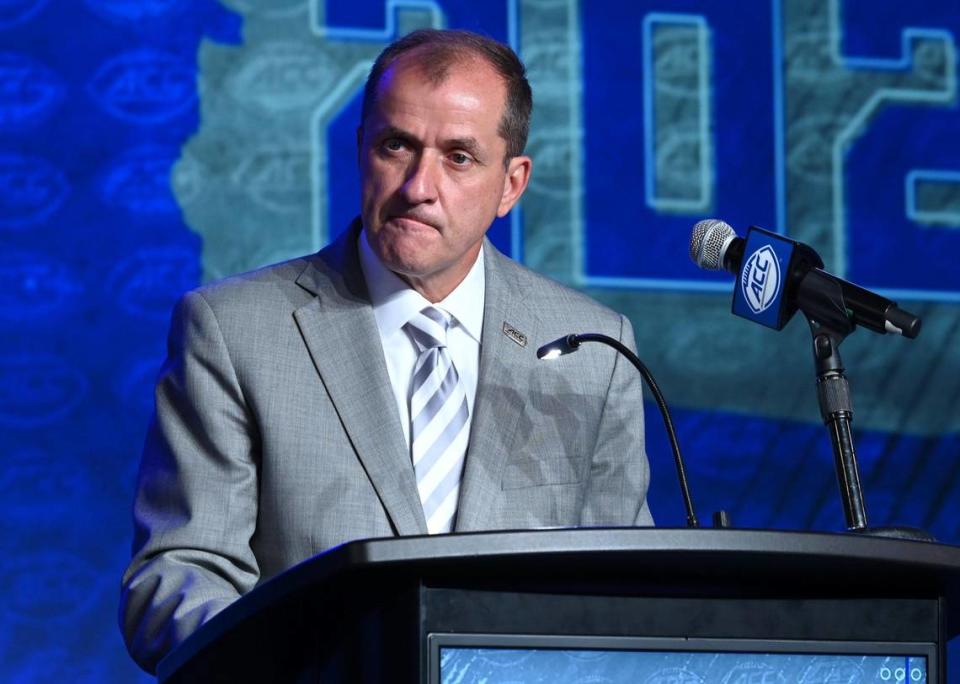Adding Cal, Stanford and SMU is the best bad idea the ACC has
Panic on the streets of Durham.
Panic on the streets of Chestnut Hill.
I wonder to myself,
could life ever be sane again?
After weeks of debate, the ACC has scheduled yet another meeting Friday morning to discuss the addition of California, Stanford and Southern Methodist, adding those three schools and, basically, taking the money they would normally get and splitting it up amongst their pre-existing conference brethren.
Reportedly, Clemson, Florida State, North Carolina and N.C. State have been providing the four “no” votes needed to block it, and good on them for it. Those four have gone from being part of the problem — some of the loudest voices at the ACC’s annual meetings, silenced by the adoption of a plan to distribute revenue based on performance instead of equally — to the solution. The airing of grievances at Amelia Island should have ushered in an era of quiet and cohesion. Instead, panic ensued.
The ACC calmly watched and took a long-term view as the SEC added Oklahoma and Texas and the Big Ten poached Southern Cal and UCLA, secure in the grant of rights that holds the conference together through 2036, or at least 2030 or so when an exit might become financially feasible.
But now, as the Pac-12 implodes, the ACC looked at the two big schools no one else wanted as the vultures picked through the wreckage and said, “Now is the time to act!” At least SMU has some football ambition; neither of the Bay Area schools have any. They’re catnip, though, for university presidents who want to sip wine at receptions with the most high-faluting peers possible.
The blame here, as it always does, lies at the feet of those presidents, who failed to act proactively from a position of relative strength and now want to act precipitously from a position of perceived weakness, chasing short-term revenue gains at the expense of everything and anything else.
With the exception of Florida State and Louisville, responses to the Big Ten adding Penn State and Maryland, respectively, the ACC’s previous expansions were all carefully planned with specific, identified goals, moving ahead of the curve. Get to 12 teams and upgrade football (even if Miami and Virginia Tech haven’t held up their end of the deal). Bring Notre Dame into the fold, even if only one-fifth of the way. Add markets for a potential ACC Network, leading directly to said network.
This isn’t action. It’s reaction.
It’s just … do something! Because everyone else is!
We’ve got to protect our phony-baloney jobs, gentlemen!
Week 1 worst case scenarios for ACC | College football Top 25 preview | Ovies + Giglio podcast
ACC already has an advantage no one else does
The grant of rights bought the ACC one thing none of the other conferences have: Time. It’s an uncommon luxury in college athletics. With the network up and running, the ACC is going to continue to stay ahead of the Big 12, and the Pac-12 is no longer a factor. For all of the whining out of Florida State, no one’s found a way around the grant of rights yet, and in the case of the Seminoles, where do they think they’re going to go, anyway?
Same for Notre Dame, which continues to act like it isn’t tied to the ACC. Outgoing athletic director Jack Swarbrick’s recent appearance on Dan Patrick’s show could be described as disingenuous at best and deliberately deceptive at worst. He referred to the ACC as “a home for our Olympic sports,” like hockey in the Big Ten, even though his president co-chaired the search committee that hired Jim Phillips as ACC commissioner to replace John Swofford.
For the moment, if the Irish joins a football conference, it has to be the ACC, a fact Swarbrick conveniently elided while playing verbal footsie with the Big Ten on Patrick’s show.
“It’d be interesting to have that discussion with each of the available conferences” and “all the major conferences are a possibility,” Swarbrick said, once again exposing Notre Dame as a 20 percent partner with a full vote in ACC matters that gives zero craps about the league.
All of which makes it awfully fishy how strongly Notre Dame is pushing the ACC to add Cal and Stanford. If you want to wonder what ulterior motives the four “no” votes might have, take a moment to consider the Irish. We’re only two years removed from Swarbrick colluding with the SEC to push through a College Football Playoff expansion plan that would have benefited those two entities most of all. Now Notre Dame is insisting a conference it won’t fully join do something many schools who are fully invested don’t want the ACC to do. A good rule of thumb in the ACC is to be against whatever Notre Dame is for. Caveat emptor.
Meanwhile, the three new schools would make the ACC measurably worse in both football and men’s basketball, the two biggest revenue-generating sports. The competitive impact, on the computer ratings that go into the CFP rankings and basketball’s NET ratings, would be instantly negative. The ACC is having a hard enough time in both sports, after getting left out of the CFP for the first and second times and twice putting only five teams in the NCAA men’s tournament. Two years in a row! In both!
Adding three schools that won a combined 30 football games and 65 men’s basketball games the past two seasons isn’t going to help anyone’s strength of schedule. You’re taking the ACC’s Level of Boston Collegeness and quadrupling it. Someone pointed out last month that the pursuit of money and success aren’t necessarily aligned. It was Phillips, quoting something a university president said to him.
“Are we chasing a dollar amount, or are we chasing success?” he said “I think there’s a difference there. If you are chasing a number, it takes you down a different path. If you are chasing success competitively in football and basketball and all of our sports, then I think every institution has an idea of what they need.”
The case for adding Cal, Stanford and SMU
So what would the ACC get out of this, and why are 11 schools behind it?
Adding the three schools, at what are essentially markdown fire-sale prices, does address the one thing university presidents really care about: more more money now now. By taking the additional money ESPN would pay the ACC for adding three schools and dividing it up among everybody else instead of actually giving it to Cal and SMU and Stanford, the ACC would now have an additional $50 million per year to pay out for performance on as yet undefined terms, but presumably tied heavily to football, as agreed this spring.
That averages out to $2.9 million per year per school, all 17.2 of them, plus any bump in network profits that might come from new cable subscriber fees in Dallas and the Bay Area, not exactly the revenue stream it was even four years ago when the ACC Network launched.
Does it help close the revenue gap with the Big Ten and SEC? Yes, by less than 10 percent. Don’t spend it all in one place. The public schools in the ACC all spend more than $100 million on athletics. Even $5 million is tip money.
But after cooking all the books, and no shortage of effort from Phillips and his staff, this is the plan that generates the most revenue for the ACC as of today. Not adding SMU alone, not adding Navy or five schools or anyone else. If dollars are all that matter, this is the option. To borrow from the CIA’s discussions in “Argo,” this is the best bad idea the ACC has, sir.
Based on potential travel schedules, most sports would only have to go to the West Coast every other year, if at all, although even that is an imposition since most teams’ long-range nonconference trips to California and Hawaii are often timed for minimal disruption. It’s a little different when someone else is telling you when to go, and routine travel up and down the East Coast is strenuous enough in the ACC already without throwing in cross-country trips.
The ACC also adds three more safe “no” votes for any potential dissolution, the most likely escape plan until the day if or when someone figures out a way around the grant of rights or the finances of an exit become workable. And at 18 schools, the ACC can lose three without giving ESPN the opportunity to re-open its deal, the real nightmare scenario some fear.
All in all, it could be worse. There is a case to be made that expansion makes sense, even if the case against expansion remains stronger, because that perceived stability comes at the cost of actual stability.
The case to wait
Clearly, the four “no” votes, even if one or more flip to yes, are going to have even happier feet than they might have now if this is forced upon them. And if schools do find a way out of the ACC, there will certainly be others willing to join at the drop of a hat, the way Louisville did. The Big Ten and SEC may be ahead of the ACC, but the ACC’s still ahead of everyone else.
So if Florida State wants to partner with private equity to buy its way out? Fine. There’s your $50 million per season right there. Farewell Seminoles and hello SMU (or Navy, or South Florida). Same for 20 percent of Notre Dame. And good riddance, honestly, now that Mike Brey is gone. Hey ACC: As many times as you do Notre Dame’s homework or give them a ride home, they’re still not going to date you.
Or ... will they? Because the one thing Swarbrick told Patrick that made sense was that Notre Dame’s football independence depended on a network partner, and he didn’t mention how NBC’s gone all-in with the Big Ten on Saturday nights.
Given the ongoing collapse of the television rights market, as the Pac-12 discovered, the ACC may be better off waiting to see what happens when Notre Dame’s football deal with NBC expires (after the 2025 season) and the Big Ten and SEC go back to market (ahead of 2030 and 2034 respectively). ESPN may not even exist as a standalone channel by then. Fox is always a wild card. In five years, the ACC’s TV deal may look a lot better than it does now.
And with the lack of interest in Cal and Stanford and SMU from other power conferences (read: television networks) to date, it’s hard to imagine their addition will make the ACC’s bargaining position any stronger when that time does come a decade from now.
In other words, the right move here is no move at all. Just because the Big Ten went coast-to-coast doesn’t mean it’s the right thing for the ACC to follow. The ACC may have missed its chance to act proactively, but that doesn’t mean it has to act reactively. If you believe in the grant of rights — and there’s no reason, at this point, not to — this is no time to panic.
Never miss a Luke DeCock column. Sign up at tinyurl.com/lukeslatest to have them delivered directly to your email inbox as soon as they post.
Luke DeCock’s Latest: Never miss a column on the Canes, ACC or other Triangle sports



